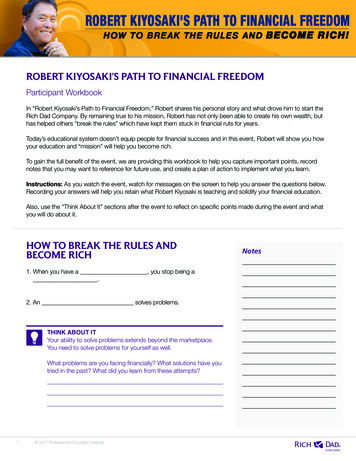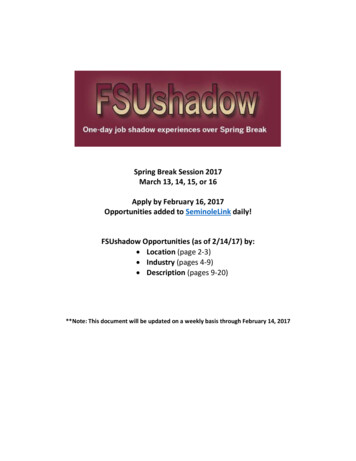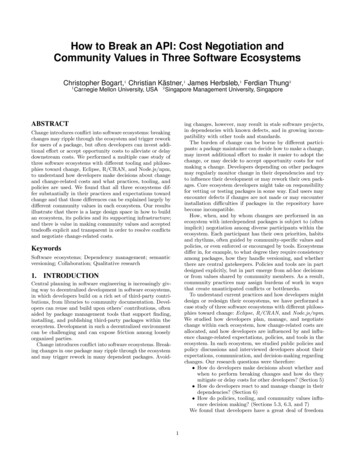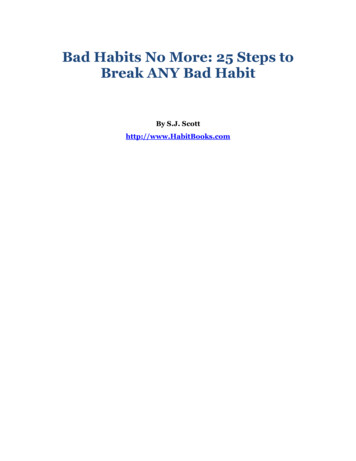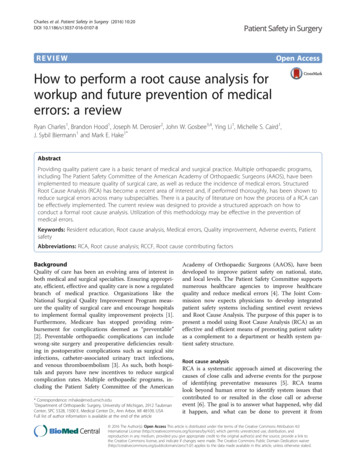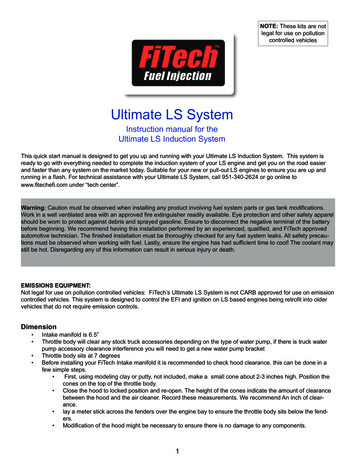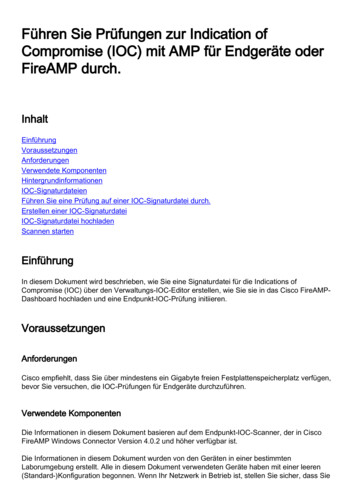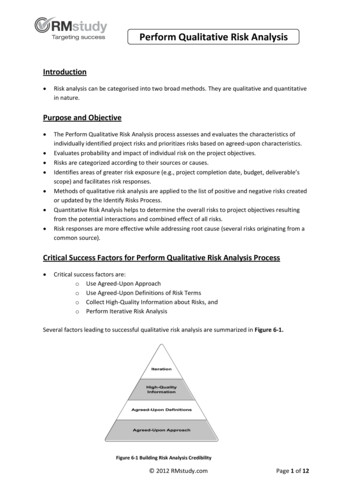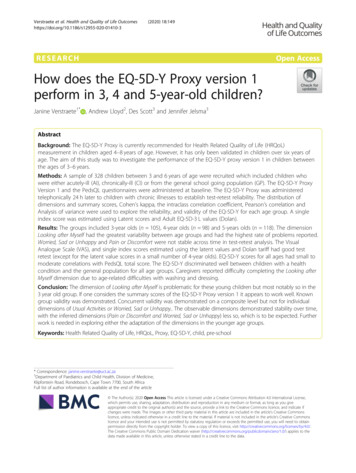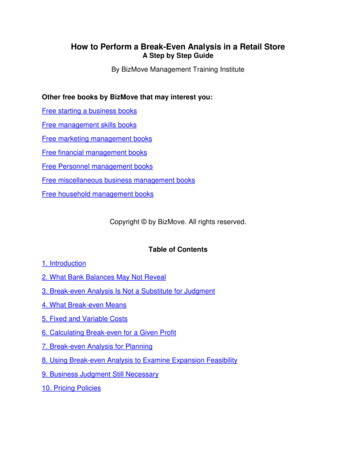
Transcription
How to Perform a Break-Even Analysis in a Retail StoreA Step by Step GuideBy BizMove Management Training InstituteOther free books by BizMove that may interest you:Free starting a business booksFree management skills booksFree marketing management booksFree financial management booksFree Personnel management booksFree miscellaneous business management booksFree household management booksCopyright by BizMove. All rights reserved.Table of Contents1. Introduction2. What Bank Balances May Not Reveal3. Break-even Analysis Is Not a Substitute for Judgment4. What Break-even Means5. Fixed and Variable Costs6. Calculating Break-even for a Given Profit7. Break-even Analysis for Planning8. Using Break-even Analysis to Examine Expansion Feasibility9. Business Judgment Still Necessary10. Pricing Policies
1. IntroductionBreak-even analysis is not a panacea. It doesn't tell you if your costs are out of line. Ittells you only what sales volume you need to cover fixed costs.It is, however, an excellent starting point for finding out where you are and, moreimportantly, where you can go. It's a good first step to planning.This Guide presented as a conversation between a business counselor (C) and theowner-manager of a retail store (M), discusses a simplified method of calculating thebreak-even point for a retail operation. While this method is not appropriate formanufacturers, it does provides a financial planning take-off point.M: I'm ready to expand. I've just had a great forth quarter. I've got a chance to move toa larger store in a good location. I really think I'm on my way. Still, though, I don't wantto take any unnecessary chances and lose what I've built up these first three years.What do you think I should do?C: Let me answer your question with a question: What's your break-even point nowand what will it be if you assume the added expansion cost?M: I'm not exactly sure, but after that last quarter, I've got money in the bank and I'mpaying all my bills on time.Go to Top2. What Bank Balances May Not RevealC: I'm glad to hear you're in good shape, but you can't make an intelligent expansiondecision based on your bank balance at a given moment.M: You ought to know, but why notC: Take your balance now, for example. It's a lot better than it was at the end of the firstquarter , isn't it?M: Sure, but the first quarter's usually slow. It's a fact of retail life.C: And the fourth quarter is usually good, right?M: Yes, that a fact, too. But mine was outstanding - it was the best I've ever had.C: I'm sure it was, but it can distort the picture. If you’re relying on your bank balance fora feel for your break-even point, you may just be guessing. Many things influence yourbank balance that may not necessarily have a direct bearing on the break-even point foryour store. Seasonal fluctuation is just one of them.M: There are more?
C: Sure, capital expenditures, extraordinary repairs, unusual outlay.M: Okay, I get the point. My bank balance is meaningless. I shouldn't expand.C: We don't know that yet. After we find out what sales volume you'll need to breakeven, then you'll tell me if you ought to expand or not.M: Some counselor. First you tell me I don't know what I'm doing and then you expectme to advise me on expansion.Go to Top3. Break-even Analysis Is Not a Substitute for JudgmentC: You're wrong on the first half of that; I know you know retailing. But, yes, you'lldecide on the basis of your business knowledge and judgment whether or notexpansion now makes sense.M: I must do something right. I'm still in business.C: Exactly. You've made it through some of the toughest business years, the first ones.And you're showing a fair profit. I think you've got a real flair for merchandising.M: Please, you'll make me blush. What about this break-even thing?Go to Top4. What Break-Even MeansC: Break-even is simply the point where costs equal what you're taking in - no profit, noloss - over a relevant sales range. To calculate this pointyou must work with only two factors, fixed expenses (like insurance or rent) and variablecosts (like cost of goods or sales commissions).M: I sure wish my costs were fixed. Everything goes up for me. My insurance, forexample, looks like it's going up 25 percent over last year.Go to Top5. Fixed and Variable CostsC: Well, actually "fixed costs" is something of a misnomer. Sure, rents, property taxes,insurance, even the salary you pay yourself may fluctuate - but on a yearly basis andnot in relation to sales. For the purpose of break-even analysis every cost that doesn'tvary in relation to sales is called "fixed". Your rent, for instance, stays the same for a
year whether you sell 250,000 or 2.50 worth of goods, though we know some rents aretied to volume and vary. The same is usually true of utilities, depreciation and similarexpense items.M: I see the point. Variable costs, then, are basically my cost of sales? I have to buymore if I sell more. If I paid commissions, I'd be paying more for more sales, and thatsort of thing.C: That's right. There can be other variable costs, but we're simplifying. In addition,you'll probably find costs that seem to be part variable, part fixed.M: You mean they're "semi-variable" or "semi-fixed?"C: Yes, they're costs that remain fixed up to a certain sales volume and then jump asthat volume is exceeded. For example, office costs, or delivery expenses may fit in thiscategory.M: How do I treat them?C: Use your good business judgment and split them between fixed and variable costs inwhat you consider a reasonable proportion. The important thing is to hold in mind forsimple break-even analysis is to keep it simple. Over simplicity is, of course, a drawbackof this method. But simple break-even analysis really helps you to see your way into aplanning problem and to establish its perimeters.M: I like the idea of simplicity, but I don't think break-even sounds simple so far.C: I think you'll see how easy it is if we work through an example. Here, take a look atthis hypothetical income or profit and loss statement for the B-E Retail Store.
M: B-E doesn't seem to have broken even.C: Correct. Let's find out what kind of sales volume B-E needed to break-even in thatyear. For simplicity (there's that word again) Let's consider cost of sales (which is 70percent of sales) as the total variable costs and the expense items of 19,200 as thefixed costs. We calculate the break-even point by using an algebraic formula.M: A simple one, I hope.C: Of course. It's just S F V, where:S Sales at the break-even point,F Fixed expenses, andV Variable costs and expenses as a percent of sales.M: All right, we know B-E's variable and fixed costs. How do we get sales?C: Let's plug in the figures:S 19,200 .70S10S 192,000 7S
O-M: Excuse me, 10S?C: I multiplied the whole equation by 10 to get rid of the decimal fraction, because Ithink it's easier to work with whole numbers.Anyway, we get:10S - 7S 192,003S 192,000S 64,000M: B-E needed 64,000 total sales to break even? Anything less, they'd have a loss;anything more they'd make a profit?C: You've got it. Let's check it, though, just to confirm it:M: Okay, so B-E has broken even. I think they'd like to make a profit. I know I do.Go to Top6. Calculating Break-even for a Given ProfitC: We can find out what kind of sales B-E needed to make a profit using the formulaagain. Leaving the other figures the same, let's put in a modest profit - say, 9,000 - andsee what sales they needed. The formula now looks like this:Sales Fixed Expenses Variable Costs Profit.M: You just add the desired amount of profit in?C: Yes, really it affects the break-even point just like a fixed expense:S 19,200 .70S 9,000 (desired profit)
10S 192,000 7S 90,000 (multiple by 10 to eliminate fraction)3S 282,000S 94,000M: May I check the figures this time?C: Certainly.M: All right, let's see:C: Convinced?M: Yes, I can see how this formula can help you find how much you need to sell tobreak even or make a given profit, but what about my problem?Go to Top7. Break-even Analysis for PlanningC: Break-even analysis is just what you need. It's primarily a planning tool. I've lookedat your Income Statement and divided it into fixed and variable costs. As I see it, yourcost of sales, which we'll consider as your total variable costs, comes to about 60percent of sales. Your fixed expenses ran about 60,000. So for last year:S 60,000 .60S10S 600,000 6S4S 600,000S 150,000You had to sell only 150,000 worth of merchandise to break even.M: As you can see, I sold 200,000 worth, but I didn't make a 50,000 profit.
C: Right, you made a 20,000 profit just as the bottom line indicates. Remember, you stillhad those variable costs on sales even after all of your fixed expenses were covered atthe 150,000 level.M: Oh, I see, it's like this:S F V ProfitS 60,000 .60S 20,00010S 600,000 6S 200,0004S 800,000S 200,000C: Now you've got it. Let's consider your expansion question. How much will your rentincrease?Go to Top8. Using Break-even Analysis to Examine Expansion FeasibilityM: It would be about 5,000 more. I figure the utilities for the larger space will be 2,000more than I paid last year. Taxes, the "fixed" ones, I expect to run about 500, I alsothink I may need to hire another sales person.C: Let's say you do. What do you plan to pay?M: I'd pay an experienced sales clerk about 9,000. I'm toying with the idea of institutinga 2 percent commission on sales as an incentive,too.C: All right. We know it's not as simple as we'll lay it out, but I think the analysis willgive you an idea of whether or not to explore the expansion idea more carefully and ingreater detail.M: FineC: Your fixed expenses will rise by 17,500, if you include hiring another employee. Thatbrings them to 77,500, assuming no other increases from last year's 60,000. Forsimplicity's sake let's assume your cost of sales (your variable costs) will increase onlyby the 2 percent commission. That means 62 percent of sales for variable costs. so:S 77,500 .62S100S 7,774,000 62S (multiplied by 100 to eliminate fraction)38S 7,775,000S 205,000 (approximately)
M: Only 5,000 more than I did last year? I can do that easily.C: And be 20,000 in profits worse off than last year. Let's put last year's 20,000 profit in- in an expansion you still might want to do at least as well:S 77,500 .62S 22,000100S 7,750,000 62S 2,000,00038S 9,750,000S 257,000 (approximately)M: Hm, that's approximately a 25 percent sales increase just to make the same profitas last year.Go to Top9. Business Judgment Still NecessaryC: Do you think you can boost sales by that much? Perhaps you see long rangebenefits from expansion that justify sacrificing some profit forthe short run.M: I'm not sure. I'll have to give it more thought, look at the trends in my business and inthis area. My pricing policy may need adjustment. Maybe I can cut costs. But now atleast I've got a starting point, a dollar figure I can work with and from. Most importantlyof all, I have a technique to help me attack my problem and help point me toward arational decision.C: That's what break-even analysis is all about.Go to Top10. Pricing PoliciesA word of caution is in order regarding the popular but misunderstood pricing methodknown as retailers mark-up. Retail mark-up means the amount added to the price of anitem to arrive at the retail sales price, either in dollars or as a percentage of the cost.For example, if a single item costing 8.00 is sold for 12.00 it carries a mark-up of 4.00 or 50 percent. If a group of items costing 6,000 is offered for 10,000, the markup is 4,000 or 66.33 percent. While in these illustrations the mark-up percentageappears generally to equal the gross margin percentages, the mark-up is not the sameas the gross margin. Adding mark-up to the price merely to simplify pricing will almostalways adversely affect profitability.
To demonstrate, assume a manager determines from past records that the business'soperating expenses average 29 percent of sales. She decides that she is entitled to aprofit of 3 percent. So she prices her goods at a 32 percent gross margin, in order toearn a 3 percent profit after all operating expenses are paid. What she fails to realize,however, is that once the goods are displayed, some may be lost through pilferage.Others may have to be marked down later in order to sell them, or employees maypurchase some of them at a discount. Therefore, the total reductions (mark-downs,shortages, discounts) in the sales price realized from selling all the inventory actuallyadd up to an annual average of six percent of total sales. To correctly calculate thenecessary mark-up required to yield a 32 percent gross margin, these reductions toinventory must be anticipated and added into its selling price. Using the formula:To obtain the desired gross margin of 32 percent, therefore, the retailer must initiallymark up his inventory by nearly 36 percent.Pricing Policies and Profitability GoalsBreak-Even Analysis and Return on Investment, discussed earlier in this section,should be reviewed at this time. Remember, all costs (direct and indirect), the breakeven point, desired profit, and the methods of calculating sales price from these factorsmust be thoroughly studied when you establish pricing policies and profitability goals.They should be understood before you offer items for sale because an omission or errorin these calculations could make the difference between success and failure.Selling StrategyProper product pricing is only one facet of overall planning for profitability. A secondmajor factor to be determined once costs, break-even point, and profitability goals havebeen analyzed, is the selling strategy. Three sales planning approaches are used (oftenconcurrently) by businesses to develop final pricing policies, as they strive to competesuccessfully.In the first, employed a
This Guide presented as a conversation between a business counselor (C) and the owner-manager of a retail store (M), discusses a simplified method of calculating the break-even point for a retail operation. While this method is not appropriate for manufacturers, it does provides a financial planning take-off point. M: I'm ready to expand. I've just had a great forth quarter. I've got a chance .
